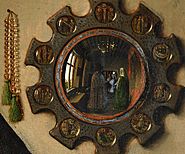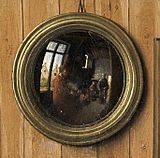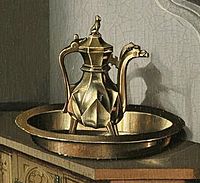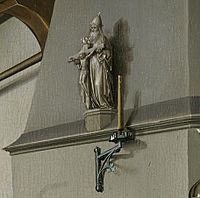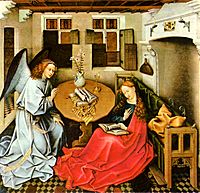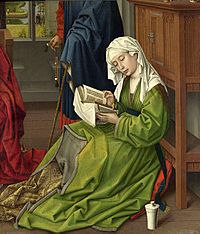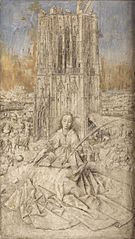The Werl Triptych facts for kids
The Werl Triptych is a special kind of artwork called a triptych, which means it has three panels. This one was finished in Cologne, Germany, in 1438. Sadly, the middle part of the artwork is now missing. The two panels that are left are kept in the Prado Museum in Madrid, Spain.
For a long time, people thought the famous artist Robert Campin (also known as the Master of Flémalle) painted it. However, some art experts now think it might have been painted by someone who worked in his studio or was a follower of his style.
The right panel shows a woman named Saint Barbara sitting and reading a holy book. She is in front of a warm fireplace that makes the room glow. The left panel shows Heinrich von Werl, who ordered the painting. He is kneeling and praying, with John the Baptist next to him. They are both looking towards where the missing middle panel would have been.
These two panels are famous for how they use light and shapes. They were very important and influenced many other artists from the mid-1400s to the early 1500s.
We know Heinrich von Werl asked for this artwork because of a message written on the left panel. He was a leader in Cologne in 1438. The panel also shows a special round mirror that reflects the room, much like a mirror in another famous painting by Jan van Eyck called the Arnolfini Portrait.
What the Triptych Shows
Even though the middle panel is gone, experts think it was set in the same room as Saint Barbara. This is because the lines of the roof and window frames seem to stop suddenly, and the light in Barbara's panel looks like it's coming from the middle. The center panel might have shown the Virgin Mary with other female saints.
The triptych probably wasn't seen by many people at first. It might have been in a private home or a hidden part of a church. But by the mid-1400s, it became very important and inspired many artists.
Many people think the panel with Saint Barbara is the best part, even though some parts of her body look a bit unusual.
Right Panel: Saint Barbara

You can tell the woman in this panel is Saint Barbara because of the tower you can see outside the window. Saint Barbara was a very popular saint in the Middle Ages. She was a Christian who lived in the 200s. The story says her rich father locked her in a tower to keep her away from men. But Barbara let a priest in, who baptized her. Her father found out and eventually cut off her head. She became a popular subject for artists like Campin. Another artist, Jan van Eyck, also painted a very detailed but unfinished picture of Saint Barbara and a Gothic tower in 1437.

The artist shows Barbara trapped in her tower, but she is busy reading a book. She has her back to a large, open fireplace. Her brown hair is loose and falls over her shoulders. She sits on a wooden bench with soft red cushions. She wears a fancy green dress with many folds. However, Barbara's body doesn't look quite right in some places; her shoulders and knees seem a bit strange.
The strength of this panel comes from the detailed way her clothes are painted and all the small objects around her. These objects are shaped and highlighted by two different light sources. The fireplace gives off a warm, reddish glow. This light is different from the brighter light coming from the window and the missing middle panel. On the fireplace ledge, there's a glass bottle, and in the chimney, there's a candle holder with an unlit candle. Above the fireplace, there is a very detailed sculpture of the Trinity (God the Father, Son, and Holy Spirit).
The room looks like a normal middle-class home from that time, not a biblical scene. It has many details similar to those in the middle panel of the Mérode Altarpiece, another painting thought to be by Robert Campin. These details include the window with its crisscross pattern and shutters, the reading Virgin Mary on a long bench, and a tilted iris flower in a vase. Art writers Peter and Linda Murray say that the way things are arranged in this later painting is much better, and the artist uses perspective (making things look far away or close) much more skillfully.
The way you look at the room is unusual; it's like you are looking down from a higher floor. This style was likely influenced by van Eyck's Washington Annunciation, painted a few years earlier. The painting uses several vanishing points (points where lines seem to meet in the distance) to make the room look deep. The steep angle of the room is created by the tilt of the bench, the side table, the fireplace, and the window shutters. According to art expert Walther Ingo, this dramatic angle makes Saint Barbara less important than the way the space itself is shown.
Left Panel: Saint John and the Donor
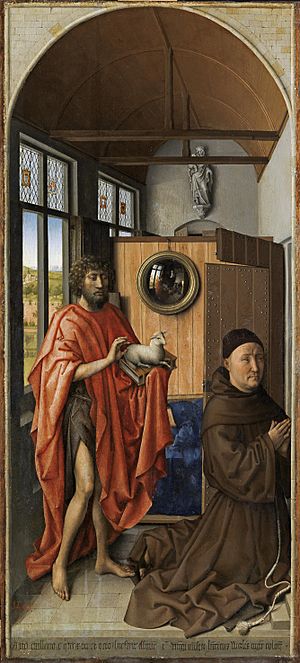
The person who paid for the painting, Heinrich von Werl, is named in a Latin message on this panel. It says: "In the year 1438 Minister Heinrich von Werl, master of Cologne, has this image painted." Von Werl was a member of the Franciscan religious order. He moved to Cologne in 1430 to study at the university and became a master there in 1435. He probably asked for this artwork for the Franciscan church in Cologne. He passed away in 1463.
This panel shows von Werl kneeling in prayer, with John the Baptist presenting him in a room with a domed ceiling. Campin was very influenced by van Eyck in the early 1430s. This panel shows that influence in several ways: how the light falls, the sharp details, and especially the round mirror in the middle that reflects the scene. This mirror is a direct nod to van Eyck's 1434 Arnolfini Marriage. The style of the writing on this panel, which tells us who the donor was and when it was painted, also looks like van Eyck's elegant writing.
This painting is a good example of early altarpieces where the person who paid for the art (the donor) is not in the main religious scene. Instead, he is in a side panel, like a witness to the holy figures who are seen through a doorway connecting to the middle panel. In Campin's Mérode Altarpiece, painted after 1422, the donor is outside in a garden. But here, Heinrich von Werl is inside. Even though a door connects the donor's space to the Virgin's space in the earlier work, it is open and seems to block his view.
Campin's early altarpieces, unlike van Eyck's, kept the traditional style where the middle panel was for the main religious scene, and it was separate from the side panels. In the Werl Triptych, the donor is just a witness, not a main character, even though he is inside. This triptych also introduces the idea of a "go-between" saint, which was another idea from van Eyck. Here, John the Baptist is shown holding a lamb in the same panel as von Werl, making the donor's area more important.
Gallery
-
The Magdalen Reading by Rogier van der Weyden, painted around 1435–1438. Van der Weyden was very influenced by Campin, as you can see in this early work.
-
Saint Barbara, an oil painting by Jan van Eyck, 1437.
See also
 In Spanish: Tríptico Werl para niños
In Spanish: Tríptico Werl para niños


